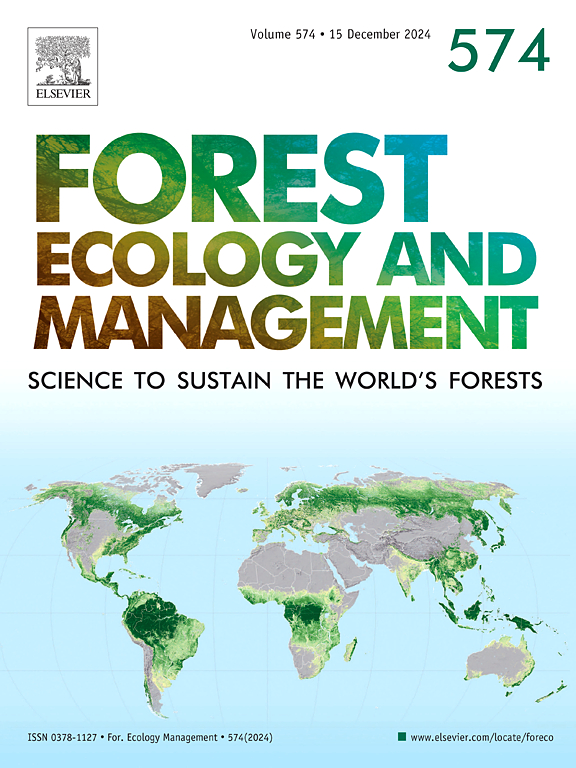幼林树木生产力对多样性效应的物种特异性响应:来自陆地激光扫描的见解
IF 3.7
2区 农林科学
Q1 FORESTRY
引用次数: 0
摘要
树木生产力对维持森林生态系统功能至关重要,但物种多样性、林分结构和群落相互作用影响幼林树种生产力的具体途径仍未得到充分探索。大多数研究关注的是林分水平的生产力,尽管个别树木的表现可能不同。本研究分析了在树木多样性试验中通过陆地激光扫描从16个样地获得的120棵单株树木,以研究树木混合如何影响桦树(Betula pendula)、橡树(Quercus robur)和山毛榉(Fagus sylvatica)的树木生产力。位于比利时的12年试验田包括单种栽培、两种混合栽培和四种混合栽培,每一种都有一个重复。定量结构模型用于重建单个树木和测量树木体积,提供独立于不可靠异速生长的生产力估计。以树木总积年平均增长量作为树木生产力指标。结构方程模型表明,物种多样性和群落相互作用是影响树木生产力的主要因素,而森林结构对树木生产力的影响不显著。功能差异、群落加权平均生长率和局地竞争显著抑制了桦木和栎树的生长。这突出了邻域组成,特别是邻树的大小和生长速度,对单个树性能的关键作用。然而,山毛榉对这些因素没有明显的反应。我们的研究结果强调了物种多样性和群落相互作用在影响新生人工林树木生产力方面的关键作用,强调了在人工林设计和管理中考虑物种特异性响应以提高森林生产力的重要性。本文章由计算机程序翻译,如有差异,请以英文原文为准。
Species-specific responses of tree productivity to diversity effects in young planted forests: Insights from terrestrial laser scanning
Tree productivity is crucial for maintaining forest ecosystem functioning, yet the specific pathways by which species diversity, stand structure, and community interactions impact species-specific tree productivity in young planted forests remain inadequately explored. Most studies focus on stand-level productivity, though individual trees may perform differently. This study analyzed 120 individual trees, obtained through terrestrial laser scanning from 16 plots in a tree diversity experiment, to examine how tree mixing influences tree productivity of birch (Betula pendula), oak (Quercus robur), and beech (Fagus sylvatica). The 12-year-old experimental plots, located in Belgium, included monocultures, two-species mixtures, and four-species mixtures, each with one replicate. Quantitative Structure Models were used to reconstruct individual trees and measure tree volume, providing productivity estimates independent from unreliable allometries. The mean annual increment for total tree volume was determined as the tree productivity indicator. Structural Equation Models revealed that species diversity and community interactions were the main factors driving tree productivity, while the impact of forest structure was not significant. Species-specifically, the growth of birch and oak was significantly suppressed by functional dissimilarity, community-weighted mean growth rate, and local competition. This highlighted the critical role of neighborhood composition, particularly the size and growth rate of neighboring trees, on individual tree performance. Beech, however, showed no significant response to these factors. Our findings emphasized the crucial role of species diversity and community interactions in influencing tree productivity in young planted forests, highlighting the importance of considering species-specific responses in plantation design and management to enhance forest productivity.
求助全文
通过发布文献求助,成功后即可免费获取论文全文。
去求助
来源期刊

Forest Ecology and Management
农林科学-林学
CiteScore
7.50
自引率
10.80%
发文量
665
审稿时长
39 days
期刊介绍:
Forest Ecology and Management publishes scientific articles linking forest ecology with forest management, focusing on the application of biological, ecological and social knowledge to the management and conservation of plantations and natural forests. The scope of the journal includes all forest ecosystems of the world.
A peer-review process ensures the quality and international interest of the manuscripts accepted for publication. The journal encourages communication between scientists in disparate fields who share a common interest in ecology and forest management, bridging the gap between research workers and forest managers.
We encourage submission of papers that will have the strongest interest and value to the Journal''s international readership. Some key features of papers with strong interest include:
1. Clear connections between the ecology and management of forests;
2. Novel ideas or approaches to important challenges in forest ecology and management;
3. Studies that address a population of interest beyond the scale of single research sites, Three key points in the design of forest experiments, Forest Ecology and Management 255 (2008) 2022-2023);
4. Review Articles on timely, important topics. Authors are welcome to contact one of the editors to discuss the suitability of a potential review manuscript.
The Journal encourages proposals for special issues examining important areas of forest ecology and management. Potential guest editors should contact any of the Editors to begin discussions about topics, potential papers, and other details.
 求助内容:
求助内容: 应助结果提醒方式:
应助结果提醒方式:


